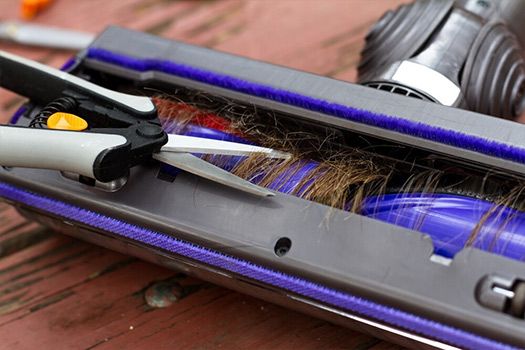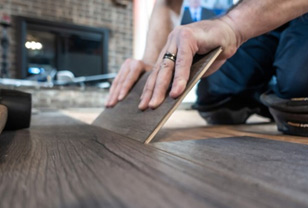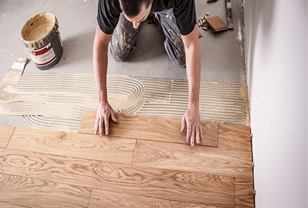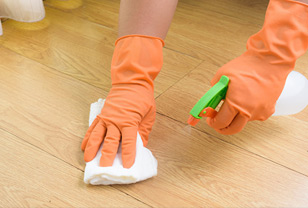Dyson Brush Bar Not Spinning: How to Troubleshoot & Fix
Although Dyson vacuums do indeed have very good build quality and can last for many years, they aren’t infallible. Occasionally, your Dyson will fail to work. It’s important that you do not panic.
Instead, sit back, find out what’s wrong with your vacuum, and decide whether to fix it yourself or send it off to a service center.
Good news: if your expensive Dyson vacuum runs into the “Dyson brush bar not spinning” fault, it’s fixable in most cases. We’ll show you everything you need to know in order to fix your Dyson vacuum at home in this guide.

Why Is the Brush on Dyson Not Spinning?
There are many different reasons why your Dyson vacuum’s brush suddenly refuses to work. We will list all of the most common problems in this segment. Go down this “Dyson vacuum troubleshooting brush not spinning” list slowly and check your Dyson as you go.
We have been very certain to write down all of the most common issues. So, if your Dyson doesn’t seem to fit any one of these cases, your problem could be more advanced. In this worst-case scenario, you will have to bring your vacuum to a service center.
The Brush Bar Is Stuck
Pet-centric Dyson DC28 brush bar not spinning? This could be the reason why.
If you use your vacuum cleaner to clean up pet hair, a stuck brush roll is something you will have to deal with eventually. Hair can clump together and form knots. The knots can weave through the brush roll’s bristles, jamming up the brush and keeping it from spinning.
It’s very important that you do not use your vacuum while the clog is still in place. If you continue using the vacuum, the brush roll’s belt can snap. You will have to spend even more time and money to replace the belt, then.
Clear up the hair clumps stuck on the brush and your vacuum will be back to working normally again. Scroll down the guide. We have detailed instructions for this procedure.

The Brush Bar Is Stuck Via: Amazon
Overheating
Every Dyson vacuum is built with an internal safety mechanism to switch itself off if the motor becomes too hot. This way, the motor won’t suffer from heat damage and be ruined for good.
Overheating is temporary and usually poses no threat to your vacuum. All you have to do is leave the vacuum sitting for 30 minutes or an hour. Once it has cooled down, you will be able to power on the vacuum again.
But that doesn’t mean you can breathe a sigh of relief. Dyson vacuums are built to run very cool, so in order for it to overheat, something must be wrong.

Your vacuum won’t ever overheat unless there’s a problem
There are two common reasons.
A clog inside of the vacuum can cause the motor to overwork itself and eventually become too hot. The second reason could be that you haven’t been cleaning your vacuum’s air filters very thoroughly, allowing dirt and debris to build up. The built-up layer of dirt causes the vacuum to overheat and shut down.
Here’s how to fix these issues.
Cleaning Up Clogs to Prevent Overheating
A clog inside of the vacuum can cause overheating, causing your Dyson to stop working. While you can simply wait a few minutes for the vacuum to cool down, if you don’t unclog it, overheating will definitely occur again.
There are two places where you need to check for clogs: the suction wand and the suction hose.
The following procedures are for the Dyson DC24, Dyson DC41, Dyson DC25, Dyson DC14, Dyson DC33, and Dyson DC50. Even if your vacuum isn’t part of the list, you can still try to follow along. Most Dyson models share the same maintenance process and design, so there shouldn’t be many differences.
First, turn off your vacuum using the power switch. Unplug the vacuum from its outlet, as well.
Place your vacuum in the upright position.
Remove the suction wand from the hose. You can find the “Detach” button at the base of the wand, on the receptacle piece between the suction hose and the wand. The button is red on most models.

Suction wand Via: Amazon
Look through the wand to see if there is any obstruction inside. If there is, you can use a blunt object like a thin rod to push it out.
If you don’t have a rod, you can fashion one for yourself with a metal coat hanger. Bend it straight and you have an unclogging tool ready to go!
As for the suction hose, another “Detach” button can be found at the base of the vacuum. It’s usually right where the hose attaches to the unit. Press it and the hose should come right out.

Suction hose Via: Amazon
Check the suction hose in the same manner as you did the suction wand.
If you can see any kind of obstruction, dislodge it with the previously mentioned tools (a thin rod or a straightened coat hanger).
How to Clean Dyson Vacuum’s Air Filters to Prevent Overheating
Cleaning the air filters on Dyson vacuums is very easy. Unfortunately, because the placement of the filters are different from model to model, it’s not possible to show step-by-step instructions for every model. But the principle is largely the same.
The very first thing to do, as always, is to shut down your vacuum and unplug it (if it’s a corded model).
Next, you need to know where the air filters are inside of the vacuum and how to remove them. You can refer to your vacuum’s user manual for this.
All recent Dysons come with what’s called a “lifetime HEPA filter.” As long as you maintain the filter properly, it should be able to last all throughout the vacuum’s lifespan.

An air filter made for the Dyson V11 vacuum Via: Amazon
Once the HEPA filter is removed from the vacuum, hold the filter over a trash can. Tap it lightly on one side to shake loose all of the dirt and debris inside.
After that, bring it over to the sink and rinse it under cold running water. Rinse until the water becomes clear.
Let the filter dry somewhere with plenty of airflow for at least 24 hours. Only after it’s completely dry, you can reinstall the filter back into the vacuum.
Do not attempt to use the filter when it’s still wet.
Broken Power Source
Damaged Power Cord
Depending on the type of vacuum you have (corded or cordless), the problem could be attributed to a broken power source. This is usually the case if, aside from the Dyson brush not spinning, your vacuum doesn’t turn on at all.
If your vacuum is a corded model, say, a Dyson DC50 Compact Animal Upright, check the power cord. The cord could have been torn at some point.
You will have to fix this problem immediately. A damaged vacuum cleaner cord is a grave electrical safety hazard. Your Dyson vacuum not working would actually be the least of your concern. It could lead to potentially lethal electrocution.
If the cord isn’t damaged (at least visibly), check the power plug. See if it sits snugly against the wall outlet. If the plug is loose, your Dyson vacuum won’t turn on when you press the power button.
Later, we’ll show you how to replace the power cord of your Dyson vacuum.
Damaged Battery
If you use a cordless Dyson, it could be the battery that’s acting up. Similar to a damaged power cord, a bad battery can also be a grave risk to you and your family’s safety.
Recent Dyson cordless vacuums are all equipped with a Lithium-ion battery. Although a Li-ion battery can store a lot of power and is generally very durable, if it were to fail, the result could be deadly.

The Li-ion battery of a Dyson V11
When a Li-ion battery cell is punctured and the lithium within reacts with oxygen, it can cause a battery fire. Though such instances are rare and manufacturers like Dyson have done a lot to make sure that this never happens, it’s still a very real possibility.
So, if you see your vacuum’s battery cell is swelling, dented, or otherwise damaged, you must take precautions.
Take the vacuum somewhere safe, like a tool shed in the backyard.
If the vacuum is visibly damaged with dents or cracks, remove the battery from the vacuum immediately. Dispose of it if you can.
Since the battery of all Dyson cordless vacuums can be replaced, throwing that old battery away wouldn’t be much of an issue.
Wrong Height Setting
If the brush continues to spin but the vacuum doesn’t suck up anything on your carpet, it’s most definitely a problem with the height setting.
We discovered this problem through a few complaints about “Dyson Ball Multi Floor brush bar not spinning.” Apparently, it’s a common issue among owners of the Dyson Ball Multi Floor vacuum.
Height, in this case, refers to the distance between the bottom of your cleaning head and the carpet piling.
For a vacuum to work properly (especially on thick carpets), the height must be just right. If it’s too low, the vacuum would suck up the carpet piling and stick the vacuum to the carpet. Vice versa, too high and the vacuum won’t pick up anything at all.
This could explain why the vacuum is running, the brush is spinning, but the Dyson doesn’t seem to do anything at all to your dirty carpet.
The Vacuum Is Improperly Locked
When you don’t need to use the vacuum anymore, it’s recommended that you lock the Dyson into an upright position. This will make it easier to store.
However, when this locking mechanism is engaged, the motor won’t work. As expected, if the motor doesn’t work, the Dyson brush won’t spin, either.
So, if you want it to work again, press the button at the bottom, near the cleaning head. It should unlock the vacuum and you can try again.
In case you don’t know where to find it, you can check the user manual for your particular model.
The Vacuum Is Not Sealed
If you have disassembled the vacuum before and didn’t reinstall everything correctly, the Dyson will also refuse to work. That includes the Dyson roller not spinning, as well.
The problem is really simple to fix. Unplug the vacuum and lay it on the ground. Check the seal around the cleaning head. If it’s a bit loose, push the cleaning head up against the vacuum’s main body.
When you hear a click, the cleaning head is finally in place. Plug the vacuum back in and try it again to see whether it has fixed the “Dyson vacuum not spinning” problem or not.
Conclusion
“Dyson brush bar not spinning” is a rather popular problem. But as you can see, it can be fixed pretty easily in most cases! You don’t even have to send your best Dyson vacuum off to a service center. All you need is some replacement parts and a screwdriver and you can do most of the fixing jobs yourself.
Hope this guide has helped you with your Dyson!
FREQUENTLY ASKED QUESTIONS
- 01. How Do You Take Apart a Dyson Roller Brush?
-
The following procedure should work for all Dyson vacuums, from the DC24 all the way to the newer V-series cordless vacuums.
Turn off the Dyson and unplug it from the electrical outlet.
Lay the vacuum on the ground, upside down. The bottom of the cleaning head needs to be facing you.
On either side of the cleaning head, you will see two circular caps. These caps hold the bottom plate that covers the brush in place. When you rotate them to the OPEN position, the plate will fall out, exposing the brush roll within.
To open the cap, you will need a coin. Place the edge of the coin into the rectangular slot at the center of the cap. Twist the cap 90-degrees to the OPEN position.
Do that for both caps, then remove the cover plate.
Untangling a Dyson Brush Roll
For moderate clogging, you can begin to remove the clogs right there. Lay the cleaning head on your lap for extra comfort. Put some paper towels on the floor and gather all of the extracted pieces of pet hair there for easier disposal later on.
Use a pair of tweezers to pick through the knots. If some of the knots are too stubborn, you can cut through them with a razor blade or a pair of scissors.

Be very careful so that you don’t damage the brush roll’s bristles.
- 02. How Do You Unlock the Brush Bar on a Dyson?
-
This will depend on the model. In a few models like in the Dyson V10, the brush bar is kept in place by a lever. You can find it on either end of the brush roll. Pull up on this lever and the brush should pop right out.
On other models like the Dyson DC41, the brush roll is kept in place by screws. Use a Phillips #2 screwdriver to remove them and the brush will fall off.
If you are unsure about this, you can check the user manual.
- 03. Can You Wash the Dyson Brush Bar?
-
Yes, you can wash the brush bar of a Dyson vacuum. We recommend washing the brush roll once every couple of months.
First, take it out of the vacuum, then rinse it under cold running water. If there is any debris or pet hair stuck on the bristle, remove them with tweezers or a razor blade.
You must let the brush air dry for at least 24 hours before reinstalling the brush. Do not, under any circumstance, operate the vacuum with a wet brush.
- 04. How Do You Take Apart a Dyson Roller BrushHow Do You Fix a Dyson Brush That Does Not Spin?
-
Replacing the Brush Belt
One component we mentioned at the beginning of the article is the belt.
This part drives the brush roll and allows it to spin. If the brush is jammed, the belt may snap. Once it does, your vacuum’s brush will stop spinning altogether, resulting in the “Dyson brush bar not spinning” fault.
To get the Dyson to work again, you will have to replace the belt.

A replacement kit composed of a replacement brush roll and two belts can be seen here Via: Amazon
Depending on the model, the steps to replacing the belt will be different. In this guide, we’ll show you the basic principle.
The first thing to do is shutting down the vacuum. Then, remove the dust cup and the filters.
Flip the vacuum upside down and look at the bottom of the cleaning head. Remove the bottom plate of the cleaning head and gain access to the brush.
Look at the motor spindle and you will see the motor belt. If it has snapped, the belt will look slackened. That’s why your Dyson brush stopped spinning.
Remove the belt by simply tugging on it. It should slide off the spindle pretty easily.
Fit the replacement belt onto the spindle and the brush roll. This part will take a bit of effort since the new belt hasn’t had time to stretch out yet.
Make sure that the belt is properly in place by pulling on it. The belt should spin when you do it.
And that’s the entire process! Pop the cover plate back into place and you can use your vacuum again.
Replacing the Battery
If your cordless Dyson is not charging, it’s a battery fault. When the battery is offline, the entire vacuum — including the brush roll — won’t work.
You can dawdle a bit if it simply doesn’t charge when you plug it in. However, if the battery is physically damaged, you need to replace it immediately. Like we said, a damaged battery is a huge hazard.
All Dyson cordless vacuums are part of the V-series vacuums. The process to remove and replace the battery is almost identical from one model to another, so it should be pretty easy.
Replacement batteries can be obtained on Dyson’s front page. Alternatively, you can contact Dyson’s customer service and ask for a replacement battery. If the vacuum is still under warranty, they may even send you one for free.
However, before we begin, we should discuss the two types of cordless Dyson vacuums available: vacuums with fixed-in batteries and vacuums with click-in batteries.
Fixed-in Batteries
Most V-series vacuums like the Dyson V7, all the way to the V11 Torque Drive, feature fixed-in batteries.

A typical Dyson fixed-in battery Via: Amazon
In this design, the battery is held in place within the vacuum with discrete screws. If you want to remove the battery, you need to remove those screws.
The screws can be removed with a standard Phillips #2 screwdriver. So, make sure to have one of these next to you before you begin.
Depending on the model, the positioning of the screws can be different. For models with vertical dust cups (Dyson V6 to V8), the arrangement of the screws will be one way. And for models with linear dust cups (Dyson V10 and above), the placement of the screws is different.
We’ll mention both in this guide.
Vertical Dust Cup
If you have a Dyson with a vertical dust cup, the first screw is hidden by the dust cup itself. So, the first step is to remove the cup.
Push two times on the red lever on the exterior of the dust cup. The entire cup will fall right out.
Look at the base of the vacuum where the battery pack is. You should see a small, black screw at the front. Remove this screw with your Phillips #2 screwdriver.
Next, turn the vacuum and look at the back handle (the grip). At the center of the grip should be another screw. Remove it.
That’s it. You can tug the battery pack downward and it should slide right out of the vacuum.
Reinstall your new battery pack by reversing the process.
Linear Dust Cup
If you have either a Dyson V10 or the V11 Torque Drive, follow this procedure, instead. The necessary tool is still a Phillips #2 screwdriver.
The first screw is located at the back of the handle in the center.
You can find the second and third screws at the bottom of the vacuum, on the underside of the battery pack. They will be at the front of the battery. Unscrew both of them.
The battery should fall right out once all three retention screws are removed.
Replace the old battery with a new one by reversing the process.
Click-in Batteries
Click-in batteries are extremely easy to replace.
The reason?
They’re specifically designed for easy and quick replacement. You can remove and replace a click-in battery in seconds.

Remove and replace a click-in battery Via: Amazon
As of now, there are only two models with click-in battery: the V11 Outsize and the V15 Detect.
Grip the battery by the bottom and gently pull it outward. The battery will simply pull out without any resistance. Take your new battery, slot it in, and push up.
The whole process, like we said, takes less than a couple of seconds.
In fact, if you purchase a Dyson V11 Outsize or V15 Detect with click-in battery, Dyson will include an extra battery in the box. You won’t even have to purchase a new battery at all.












